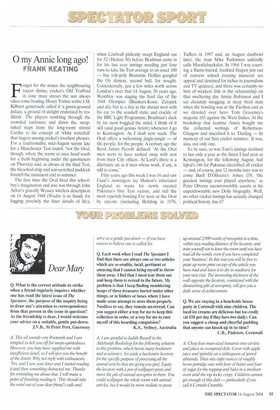0 my Annie long ago!
FRANK KEATING
Forget for the nonce the neighbouring soccer shrine; cricket's Old Trafford in (one must stress) the sun always takes some beating. Hoary Yorkie scribe J.M. Kilburn generously called it 'a green-grassed palace, a ground of delight enshrined by tradition'. The players tumbling through the crowded enclosure and down the steepraked steps from the long-room stirred Cardus to his concept of 'white waterfall' that lingers among cricket's loveliest phrases. For a traditionalist, mid-August seems late for a Manchester Test match. Not the Oval, though, where the teams at once head south for a fresh beginning under the gasometers on Thursday and, as always at the final Test, the bleached strip and sun-scorched paddock foretell the imminent end to summer.
The first time the Oval fired this schoolboy's imagination and awe was through John Arlott's gravelly Wessex wireless description on 14 August 1948 (Wisden is so handy for logging precisely the finer details of life), when Lindwall pitilessly swept England out for 52 (Hutton 30) before Bradman came in for his last ever innings needing just four runs to take his Test average to an exact 100 — but roly-poly Brummie Hollies googled the Oz demon, second bail, for nought. Coincidentally, just a few miles north across London's river that 14 August, 56 years ago, Wembley was staging the final day of the 1948 Olympics (Blankers-Koen, Zatopek and all), but to a boy in the distant west with his ear to the seashell static and crackle of the BBC Light Programme, Bradman's duck by far most boggled the mind. I think of it still (and good genius Arlott) whenever I go to Kennington. As I shall next week. The Oval offers a welcoming jingle-jangle — of the people, for the people. A century ago the Revd James Pycroft defined: 'At the Oval men seem to have rushed away with zest from their City offices. At Lord's there is a dilettante air as if men whose work, if any, is still to come.'
Fifty years ago this week I was 16 and saw Fazal's inswingers lay Hutton's infuriated England to waste for newly created Pakistan's first Test victory, and still the most viperish bowling I've seen at the Oval by anyone (including Holding in 1976, Tuffers in 1997 and, an August dustbowl later, the man Mike Parkinson unkindly calls Muralichuckalot. In 1966 I was courting a flame-haired, freckled fizzpot just out of convent school (oozing innocent sex appeal and destined for riches in journalism and TV quizzes), and there was certainly no hint of weakest link in the relationship on that sweltering day Annie Robinson and I sat dreamily snogging at deep third man when the bowling was at the Pavilion end as we drooled over hero Tom Graveney's majestic 165 against the West Indies. At the bookshop that teatime Annie bought me the collected writings of RobertsonGlasgow and inscribed it to 'Darling — In memory of our first cricket summer.' It was, alas, our only one.
To be sure, so was Tom's innings destined to last only a year as the finest I had seen at Kennington, for the following August Asif Iqbal's 146 for Pakistan electrified all cricket — and, of course, just 12 months later was to come Basil D'Oliveira's Ashes 158, 'the greatest innings ever played anywhere.' as Peter Oborne incontrovertibly asserts in his unputdownable new Dolly biography. Well, no other cricket innings has actually changed political history, has it?


























































 Previous page
Previous page